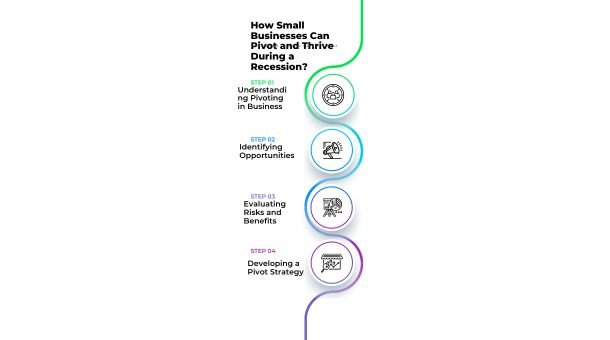The current economic situation, marked by [provide context on the specific economic situation, such as the recent pandemic, financial crisis, or market downturn], has significantly impacted small businesses.
The effects of a recession can be devastating, causing revenue decline, reduced consumer spending, and increased competition. However, amidst these challenges, small businesses have the opportunity to pivot and find new avenues for growth and success.
In this article, we will explore the concept of pivoting, its importance during a recession, and provide practical strategies to help small businesses pivot effectively. By embracing change and seizing new opportunities, small businesses can not only weather the storm of a recession but also thrive in the face of adversity. lets get started!

Understanding Pivoting in Business:
To begin, it is essential to understand the concept of pivoting. In the business context, pivoting refers to the act of shifting or adapting a company’s core strategy, products, or target market to better align with changing circumstances.
During a recession, businesses need to pivot to overcome the challenges brought on by economic uncertainty and consumer behavior shifts. Pivoting can take different forms, such as changing business models, diversifying product offerings, entering new markets, or targeting different customer segments.
Identifying Opportunities:
The first step in successful pivoting is identifying new opportunities that align with the changing economic landscape. This requires conducting thorough market research to understand emerging trends, consumer needs, and potential gaps in the market.
Analyzing shifts in customer behavior, preferences, and spending patterns is crucial for identifying areas where a pivot can be effective. Additionally, exploring untapped markets or niche segments can present new avenues for growth and profitability.
Evaluating Risks and Benefits:

| Risks | Benefits |
| Potential financial loss | Increased revenue or profitability |
| Negative customer feedback | Enhanced customer satisfaction |
| Regulatory compliance issues | Improved brand reputation |
| Increased competition | Market expansion opportunities |
| Implementation challenges | Process optimization |
| Resource constraints | Enhanced team collaboration |
| Technology limitations | Increased efficiency and productivity |
Developing a Pivot Strategy:
A pivot cannot be successful without a well-developed strategy. Small businesses should create a detailed plan outlining the steps required to execute the pivot successfully.
This plan should include setting clear goals, establishing timelines, and identifying the resources needed for implementation. By mapping out the pivot strategy, businesses can navigate the transition more effectively and increase their chances of success.
Get Investing Books:

Richer, Wiser, Happier
Implementing the Pivot:
Effective implementation is key to a successful pivot. It is crucial to manage the transition process smoothly, ensuring that all stakeholders are aligned and informed.
Clear communication with employees, customers, and suppliers is vital to minimize disruption and build trust. Businesses should provide training or reorientation for employees involved in the pivot and allocate resources accordingly to support the new direction.
Marketing the Pivot:
A well-executed marketing strategy is essential to communicate the value of the pivot to customers and stakeholders. Developing a messaging framework that highlights the benefits of the new direction and resonates with the target audience is crucial.
Choosing the right marketing channels to reach and engage customers is equally important. Leveraging digital marketing, social media, and targeted advertising can help raise awareness and generate interest in the pivoted business offerings.
Investing in the Right Resources:
To support the pivot, it is necessary to assess the resources required and prioritize spending on the most important areas. This may involve reallocating existing resources, investing in new technologies or equipment, or hiring additional talent.
Small businesses should carefully consider alternative funding options, such as loans, grants, or partnerships, to ensure they have the necessary financial means to execute the pivot effectively.
Measuring Success:
Tracking key metrics is essential to evaluate the success of the pivot. Monitoring indicators such as revenue growth, customer acquisition, customer satisfaction, and market share will help assess the impact of the pivot over time. Regular evaluation of these metrics allows businesses to make adjustments and refinements to their strategy as needed.
Case Studies: Successful Pivots During Recessions:

Examining case studies of small businesses that successfully pivoted during past recessions provides valuable insights and inspiration. By studying these examples, business owners can learn lessons and gain practical knowledge about how to pivot effectively.
These case studies highlight innovative strategies, creative thinking, and the ability to adapt to market changes, leading to thriving businesses even in challenging economic climates.
Building Resilience for the Future:
Pivoting should not be seen as a one-time solution but as an ongoing strategy for building resilience. Small businesses should incorporate pivoting as a core element of their business planning.
By continuously monitoring the market, staying agile, and being open to change, businesses can proactively adapt to future economic uncertainties and position themselves for long-term success.
Conclusion
Pivoting during a recession can be a transformative experience for small businesses. By understanding the concept of pivoting, identifying new opportunities, evaluating risks, and developing a strategic plan, businesses can successfully navigate through challenging times.
Effective implementation, marketing, and resource management are key to executing a pivot smoothly. Measuring success through key metrics and learning from past case studies provides guidance for future endeavors.
Ultimately, by embracing change and incorporating pivoting as a core business strategy, small businesses can not only survive but thrive during a recession and build resilience for the future. The time to pivot is now—take action and unlock new possibilities for your business’s growth and success.
| business strategy during recession |
| strategic planning during recession |
| small business during recession |
| how to recession-proof your business |
| effects of recession on small businesses |
| tips for surviving a recession as a small business in 2023 |

